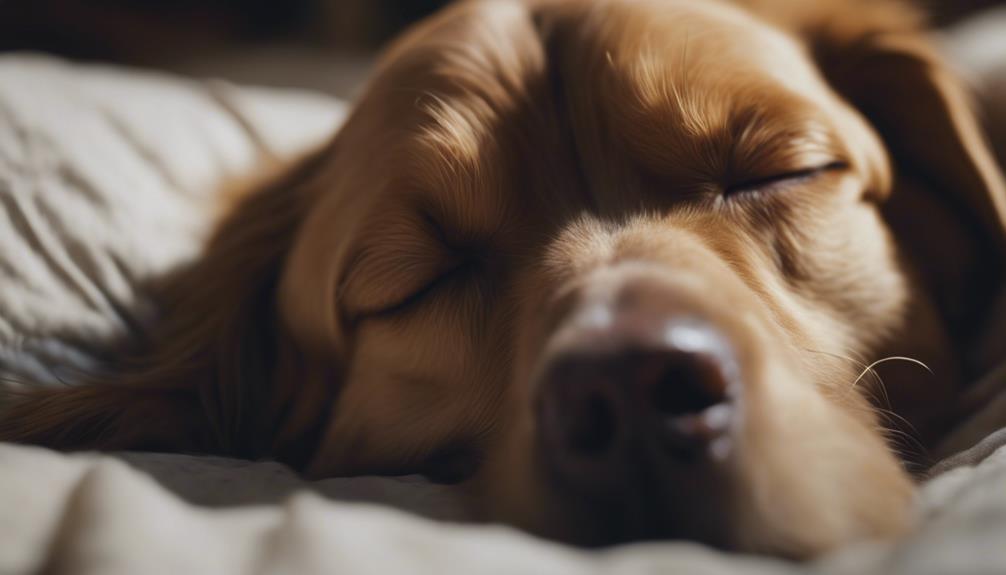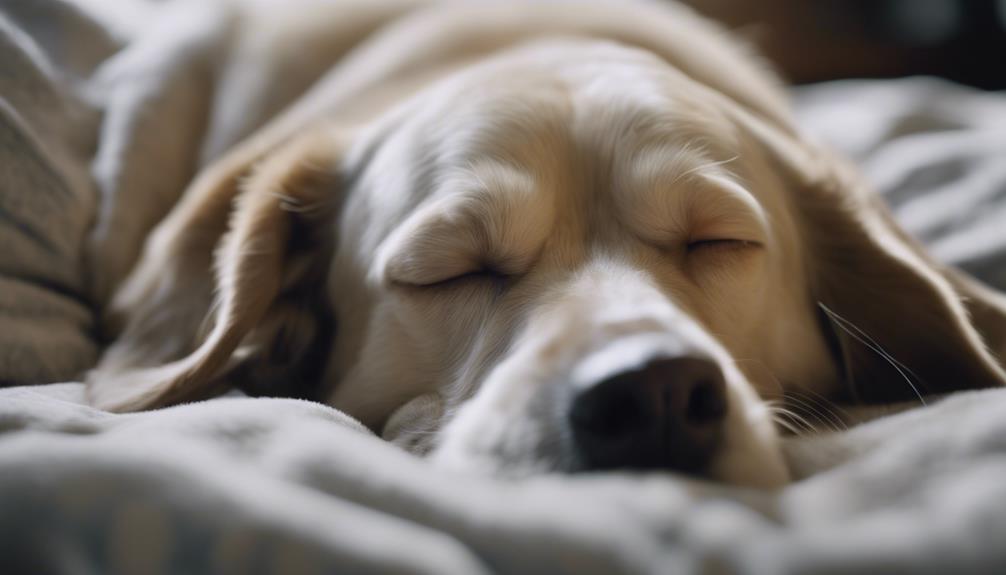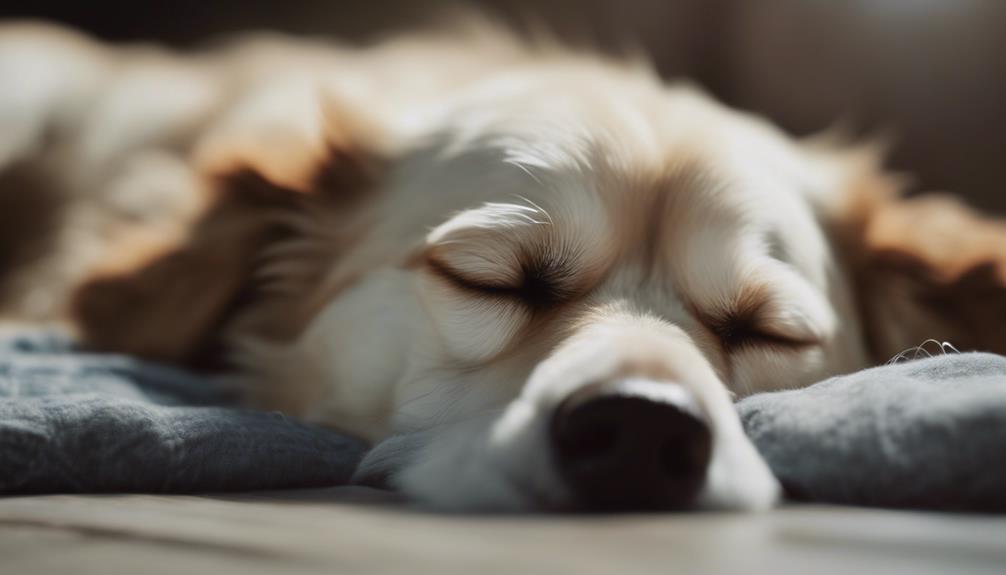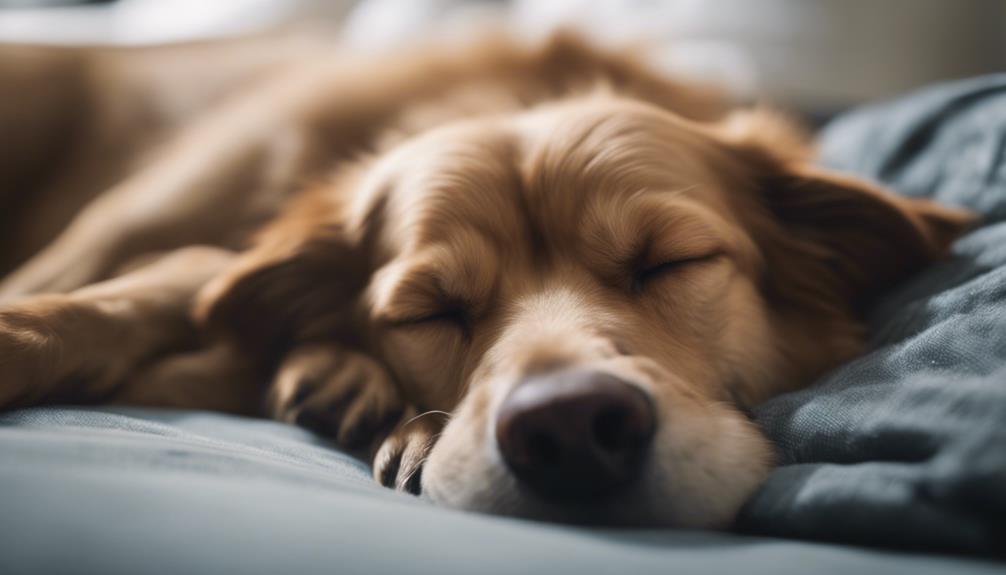As dog owners, we often find ourselves entranced by the sight of our beloved companions twitching and moving during their slumber. It raises the question: Is there more to these seemingly random movements than meets the eye?
Understanding the intricacies of a dog's sleep behavior can provide valuable insights into their overall well-being. By unraveling the mysteries behind these nighttime activities, we can gain a deeper appreciation for the fascinating world of canine sleep patterns and the significance of those adorable twitches our furry friends display.
Key Takeaways
- Dog twitching during sleep is normal, especially during REM phase.
- Puppies and senior dogs may exhibit more movement during sleep.
- Excessive twitching and vocalizing may indicate REM sleep disorder.
- Quality sleep and completed REM cycles are vital for dog health.
Understanding Dog Sleep Cycles
Dog sleep cycles, akin to those of humans and other mammals, encompass distinct phases crucial for their overall well-being. These cycles consist of wakefulness, rapid-eye-movement (REM) sleep, and non-rapid-eye-movement sleep. Observing a dog's sleep can provide insights into their overall health.
During REM sleep, dogs may exhibit eye movement, changes in breathing, leg movement, and occasional vocalizations. This phase is vital for various functions, including dreaming, memory consolidation, and emotional processing. Understanding these sleep patterns helps in identifying normal behaviors during sleep, such as occasional twitching or kicking.
Monitoring a dog's sleep habits and behaviors can aid in recognizing any irregularities that may require further attention to ensure the pet's well-being.
Importance of REM Sleep
Crucial for cognitive functions and emotional processing, the REM sleep stage plays a vital role in maintaining a dog's overall health and well-being.
During REM sleep, dogs experience dreaming which aids in memory consolidation.
REM sleep is essential for emotional regulation and processing experiences.
Lack of sufficient REM sleep can lead to cognitive dysfunction and behavioral issues.
Observing REM Sleep in Dogs

During the REM sleep stage in dogs, noticeable physiological indicators such as eye movement, changes in breathing, and muscle twitching signify the transition into this crucial phase of the sleep cycle.
REM sleep is characterized by rapid eye movements, irregular breathing patterns, and increased brain activity similar to that of wakefulness. These observable signs suggest that dogs are in a state conducive to dreaming, memory consolidation, and emotional processing.
Monitoring these physical cues can help pet owners understand their dog's sleep patterns and ensure they are experiencing essential stages of rest. While occasional twitching and movement are normal during REM sleep, excessive or prolonged episodes may warrant veterinary attention to rule out any underlying health concerns.
Normal Sleep Phases in Dogs
In the sleep cycle of dogs, distinct phases play a vital role in maintaining their overall health and well-being. Dogs typically go through different sleep phases similar to humans, including wakefulness, REM (rapid eye movement), and non-rapid-eye-movement sleep. These phases are crucial for various functions such as memory consolidation, learning, and overall physical restoration.
- Wakefulness: Dogs are alert and responsive during this phase, which helps them stay aware of their surroundings.
- REM (Rapid Eye Movement) Sleep: This phase is essential for dreaming, memory processing, and emotional regulation.
- Non-Rapid-Eye-Movement Sleep: A deeper sleep phase where the body focuses on physical restoration and growth.
Understanding these sleep phases can provide insights into your dog's behavior and overall well-being.
The Role of the Pons

The pons in a dog's brain stem plays a significant role in regulating muscle control during the REM stage of sleep. As a crucial part of the brainstem, the pons coordinates various functions, including breathing, facial sensation, and eye movement.
During REM sleep, the pons inhibits muscle activity, preventing the manifestation of dream movements into physical actions. This inhibition ensures that dogs do not physically act out their dreams, which could be potentially harmful. However, occasional twitching and kicking movements may still occur as a natural part of the dreaming process.
Understanding the role of the pons in controlling muscle activity during REM sleep helps explain why dogs may exhibit twitching behavior during this sleep stage.
Twitching and Breathing in REM
Regulating muscle activity and breathing patterns, the pons in a dog's brain stem plays a crucial role during the REM stage of sleep. This phase is characterized by rapid eye movements, irregular breathing, and heightened brain activity.
The following are key points to understand about twitching and breathing in REM sleep:
- Muscle twitching: Occasional kicking or twitching is normal and indicates the brain is actively processing information.
- Irregular breathing: Changes in breathing patterns during REM sleep are typical as the body transitions through different stages of relaxation.
- Brain activity: The brain is highly active during REM sleep, contributing to dreams and mental processing.
Understanding these behaviors can help pet owners distinguish between normal sleep patterns and potential health concerns in their dogs.
REM Differences in Dogs

During the REM stage of sleep, dogs exhibit distinct variations in their sleep patterns compared to other mammals. Unlike humans who spend a significant portion of their sleep in REM, dogs have shorter REM phases that occur after about 20 minutes of sleep and last approximately 5 minutes.
During REM sleep, dogs may display movements like twitching, kicking, and vocalizing, which are normal behaviors. Puppies and senior dogs tend to exhibit more movement during REM sleep due to developmental differences. The pons in the brainstem regulates muscle control during REM sleep, contributing to these movements.
Understanding these REM differences in dogs can help pet owners differentiate between normal sleep behaviors and potential sleep disorders that may require veterinary attention.
Impact on Sleep Quality
Understanding the impact of dog twitching in sleep on their overall sleep quality is crucial for maintaining their health and well-being.
- Quality of Rest: Twitching can disrupt the dog's sleep cycle, affecting the duration and quality of rest they receive.
- Physical Well-being: Continuous or excessive twitching may lead to muscle fatigue or soreness, impacting the dog's physical health.
- Behavioral Changes: Poor sleep quality due to frequent twitching can result in irritability, restlessness, or other behavioral changes in dogs.
Sleep Duration in Dogs

What factors influence the ideal sleep duration for dogs?
The ideal sleep duration for dogs can vary depending on several factors such as age, breed, health, and activity level. On average, dogs snooze around 12 hours a day, with shorter sleep cycles lasting about 45 minutes each.
Puppies and senior dogs tend to require more sleep than adult dogs due to their developmental stage or age-related changes. Larger breeds may also need more rest compared to smaller breeds.
Ensuring that your dog gets enough quality sleep, including completing essential REM cycles, is crucial for their overall health and well-being. Monitoring your dog's sleep patterns and adjusting their routine accordingly can help maintain their optimal sleep duration.
Age-Related Movement in Sleep
With age, dogs may exhibit varying degrees of movement during sleep, reflecting developmental differences and physiological changes in their sleep patterns. This age-related movement in sleep can be attributed to several factors:
- Muscle Weakness: Senior dogs may experience muscle weakness, leading to more pronounced twitching and kicking during sleep.
- Joint Stiffness: Older dogs often have joint stiffness, causing increased movement as they try to find a comfortable sleeping position.
- Neurological Changes: Age-related neurological changes can result in more frequent and intense dream activity, leading to visible movements during sleep.
Understanding these age-related factors can help pet owners differentiate normal sleep behavior from potential health concerns in their aging furry companions.
Health Benefits of REM

Age-related changes in dogs' sleep patterns not only reflect physical alterations but also highlight the importance of REM sleep for their overall health. REM (rapid eye movement) sleep is crucial for dogs as it supports various physiological functions necessary for their well-being. Here is a table illustrating the health benefits of REM sleep:
| Health Benefits of REM Sleep | |
|---|---|
| Memory Consolidation | Enhances learning and memory retention. |
| Emotional Regulation | Helps in processing emotions and maintaining mental health. |
| Physical Restoration | Supports overall bodily repair and growth. |
| Cognitive Function | Aids in problem-solving and decision-making abilities. |
| Stress Reduction | Plays a role in managing stress levels and promoting relaxation. |
Identifying REM Sleep Disorder
An important aspect in canine health involves recognizing potential indicators of REM sleep disorder in dogs.
- Irregular Movements: Dogs experiencing REM sleep disorder may exhibit excessive twitching and jerking movements during sleep.
- Vocalization: Persistent vocalizing or whimpering while asleep could be a sign of REM sleep disorder.
- Abnormal Behavior: If your dog shows signs of distress or appears disoriented during sleep, it may indicate a problem with REM sleep.
Identifying these symptoms is crucial in determining if your dog is experiencing REM sleep disorder, which may require veterinary evaluation and treatment to ensure your pet's well-being.
Signs of Neurological Issues

Early detection of signs of neurological issues in dogs is crucial for timely intervention and proper management of their health. Symptoms such as persistent twitching, uncontrolled movements, seizures, or changes in behavior can indicate underlying neurological problems.
Dogs experiencing neurological issues may show signs like coordination difficulties, muscle weakness, abnormal eye movements, or altered responsiveness to stimuli. Additionally, behavioral changes such as increased aggression, confusion, or disorientation could point towards neurological concerns.
It's essential to monitor your dog's overall well-being and promptly seek veterinary care if you notice any of these signs. Timely diagnosis and appropriate treatment can help address neurological issues effectively and ensure your dog's health and quality of life.
Seeking Veterinary Attention
Timely veterinary attention is crucial when observing concerning signs related to your dog's health, such as persistent twitching, uncontrolled movements, or changes in behavior, to ensure proper diagnosis and management.
- Signs that require immediate veterinary attention:
- Seizure-like episodes during wakeful periods.
- Persistent twitching or vocalizing during sleep.
- Unexplained changes in behavior or coordination.
Prompt veterinary evaluation can aid in identifying underlying issues, such as seizures, REM sleep disorders, or neurological conditions, and facilitate appropriate treatment. Early intervention plays a vital role in maintaining your dog's well-being and quality of life. If you notice any of these signs, it is essential to consult a veterinarian promptly for a comprehensive assessment and tailored care plan.
Are Dog Zoomies and Twitching in Sleep Related to Normal Canine Behavior?
Many pet owners wonder about the reasons for dog zoomies and twitching in sleep. Dog zoomies, or sudden bursts of energy, are a normal behavior for canines and can be a way for them to release pent-up energy. Twitching in sleep is also a common behavior and is believed to be connected to the dog’s dream state.
Conclusion
In conclusion, understanding the normal behaviors and patterns of a dog's sleep cycle, particularly during REM sleep, is essential for monitoring their overall health and well-being.
By observing and recognizing the significance of twitching and movements during sleep, pet owners can distinguish between normal behaviors and potential neurological issues.
Seeking veterinary attention if abnormal behaviors persist is crucial for ensuring the vitality and longevity of our furry companions.




